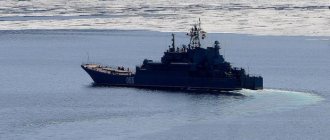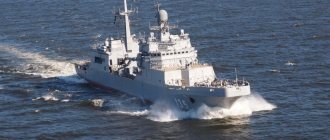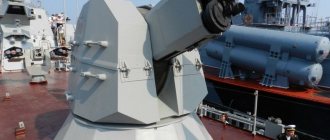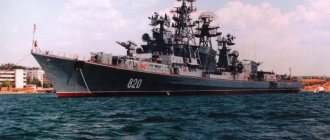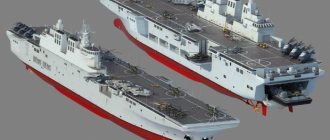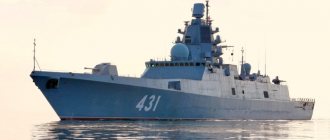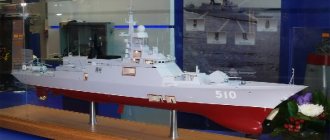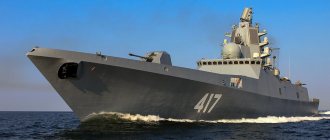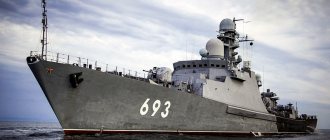The Project 775 large ocean zone landing ship was designed to transport and land landing forces with military equipment on both equipped and unequipped coasts with a low bottom slope. These ships were laid down and built at the Stocznia Polnocna shipyard in Gdansk (Poland) from 1974 to 1985. A total of 17 ships of this project were built.
Let's take a closer look at the history of the creation of ships, their tactical and technical characteristics, design, armament, description of the ships of the project BDK "Minsk", BDK "Olenegorsky Miner".
Development history
The Navy needed to replace the aging large landing ships of Project 1171, created on the basis of a dry cargo ship. Their successors had to be designed specifically for landing operations, have greater survivability and weapons power. The new ships were supposed to stand in importance between the Project 1174 BDK (Rhinoceros) and medium landing ships. Design of the 775 was carried out in the Polish People's Republic.
Appetite comes with eating
Large landing ships of Project 1171
Having tested the Shinshu Maru in combat conditions, the Imperial Army wanted more. Having saved up money, in the summer of 1941 she commandeered the unfinished liner, and in January 1942 the second landing ship entered service under the name Akitsu-maru. This time, the army was able to realize their wishes and equipped the ship with a flight deck almost the entire length, which made it possible to lift aircraft under its own power.
But landing, again, was not planned.
In addition to 27 daihatsu and 20 aircraft, the ship also carried a pair of Kayaba Ka-1 gyroplanes. So, in some ways, it can also be considered the first amphibious helicopter carrier in history.
The world's first aircraft-carrying landing ship "Akitsu-maru"
After 1942, there was no talk of any Japanese landing operations. But the Imperial Army, with tenacity worthy of better use, continued to churn out landing craft. Having built a total of ten units. Naturally, they could no longer have any influence on the course of the war.
Design
The ship has a developed aft superstructure. At the stern there is a sealed folding lapport, necessary for loading equipment from the pier when moored by the stern. The tank hold runs along the entire length of the hull, connecting the lapport and the bow ramp, which allows amphibious vehicles to be dropped into the sea in seas up to 4 points.
Armament
To shell coastal fortifications and destroy enemy personnel, Project 775 landing ships use two MS-73 MLRS A-215 Grad-M launchers of 122 mm caliber, capable of firing at intervals of 0.5 seconds to a range of 21 km. As for artillery weapons, the BDKs have two twin 57-mm AK-725 guns with remote guidance. To enhance the firepower and air defense systems on the Project 775M BDK, instead of two AK-725s, an artillery complex was installed, which included one AK-176 installation and two AK-630M installations.
Radio-technical weapons
The guidance mechanisms on Project 775 and 775/II ships are controlled using MP-103 Bars fire control devices, and on Project 775/III ships a unified MP-123/176 Vympel fire control system is installed to control artillery weapons. To control rocket artillery fire, the PS-73 “Groza” fire control system was installed.
Also, the ships of the project are equipped with an MP-302 “Rubka” general detection radar with a range of up to 100 km (on ships of Project 775/III, instead of the MP-302, the MP-352 “Positive” is installed) and two navigation radars MP-212/201 with range up to 64 km (during construction and modernization, various navigation radars could be installed on ships: “Don”, “Vaigach”, “Mius”).
Landing capabilities
Troop capacity:
- 10 medium tanks and 340 people.
- 12 armored vehicles and 340 people.
- 3 medium tanks, 3 self-propelled guns 2S9 “Nona-S”, 5 MT-LB, 4 trucks and 313 people.
Or:
- option 1 - 13 medium (main) tanks;
- option 2 - 13 armored personnel carriers;
- option 3 - 20 trucks;
- landing personnel (for all loading options) - 150 people.
The dimensions of the cargo compartment are 55 × 6.5 × 4.5 m + 40 × 4.5 × 4.5 m, cargo weight is up to 480 tons. The landing force is accommodated in several cockpits and 4-berth officer cabins.
Leapfrog on the slipway
So what to build?
After some thought, the Russian Navy command decided to abandon the logical idea of building an improved version of the Project 1174 landing craft: it was extremely expensive and difficult (remember, it was the 1990s). An alternative and relatively cheap option for building a troop transport in the hull of some kind of roller-rotor carrier in the interests of the Navy also did not arouse interest among the Fleet command. In general, to replace the old “paratroopers” they wanted to get new “paratroopers”, but for what specific tasks - it seems that no one really imagined this. Therefore, the terms of reference for the new ship turned out to be quite vague. From the series “Go there, I don’t know where, and build something there, I don’t know what.” The design of the future BDK Project 11711 began according to the technical specifications of the Russian Navy in 1998 at the Nevsky Design Bureau in St. Petersburg. Since finances at that time were openly singing romances, at first there was talk of building something very small, like a new medium landing ship. But quite quickly, common sense won out, and apparently the means were found, so the project for a new landing ship was reformulated into the BDK project.
To speed up the design, it was decided to use for the new BDK the dimensions and hull contours of the well-proven Project 1171 BDK (built in 1964–1975). This limited the displacement of the future new BDK to 5,000 tons. In general, the Nevsky PKB produced a classic Soviet BDK. However, there were also differences: two (bow and stern) superstructures instead of one, a helicopter hangar, a pair of Ka-29 helicopters, as well as improved living conditions for the crew and troops.
/ Ministry of Defense of the Russian Federation
On December 23, 2004, at the shipbuilding plant in Kaliningrad, the first BDK of Project 11711, named Ivan Gren, was laid down. Then the leapfrog began. The Navy command with enviable consistency changed its views on the future use of the Gren, which led to constant adjustments to the project of the ship that had already begun construction.
For example, initially the BDK’s armament was supposed to consist of a 100-mm A-190M artillery mount, two Broadsword anti-aircraft artillery systems and two launchers of the A-215 Grad-M multiple launch rocket system. But then all this “splendor” shrank to one dual-automatic 30-mm automatic artillery mount “Duet”, a pair of 30-mm six-barreled automatic artillery mounts AK-630M, a pair of 14.5-mm pedestal machine gun mounts “Sting” and a complex of fired passive jammers.
In addition, it was initially assumed that the BDK would land equipment ashore “contactlessly.” That is, before reaching the shore, it will anchor, lower the bow ramp and build a pontoon bridge from it to the shore. Then the idea of “contactless” was abandoned. Then they returned to her. Then... Well, in general, you understand.
All this over and over again “cut” the project and the ship itself under construction “to the quick,” pushing back the completion date in every possible way. At the same time, stealth technologies began to be introduced into the design of the ship. At the same time, interruptions in financing began. At the same time, Russia began to think about purchasing universal Mistral economy-class landing ships from France, which called into question the need to complete the construction of the lead landing ship of Project 11711...
wikipedia.org/
Composition of the series
The construction of large landing ships of Project 775 took place from 1974 to 1985. The construction of the lead ship "SDK-47" (serial number - 1) was carried out in 1974 in the Polish People's Republic. A total of 25 ships were built in this project, and 3 ships in project 775M (with modernized weapons). One of the 775 ships was exported to Yemen in 1979.
Project 775:
- SDK-47 (BDK-47); Board number - 134; Serial number - 775/1; Put into operation - 07/01/1974; Fleet - BF
- SDK-48 (BDK-48); Board number - 061; Serial number - 775/2; Put into operation - 06/30/1975; Fleet - Pacific Fleet
- SDK-63 (BDK-63); Board number - 083; Serial number - 775/3; Put into operation - 06/30/1975; Fleet - Pacific Fleet
- SDK-90 (BDK-90); Board number - 058; Serial number - 775/4; Put into operation - November 30, 1975; Fleet-Pacific Fleet
- SDK-91 (BDK-91), “Olenegorsky miner”; Board number - 012; Serial number - 775/5; Put into operation - 06/30/1976; Fleet - SF
- SDK-181 (BDK-181); Board number - 083; Serial number - 775/6; Put into operation - 10/09/1976; Fleet - Pacific Fleet
- SDK-182 (BDK-182), "Kondopoga"; Board number - 027; Serial number - 775/7; Put into operation - November 30, 1976; Fleet - SF
- SDK-183 (BDK-183), "Kotlas"; Board number – 035; Serial number - 775/8; Put into operation - 03/15/1977; Northern Fleet
- SDK-197 (BDK-197); Board number – 055; Serial number - 775/9; Put into operation - 09/21/1977; Fleet - Pacific Fleet
- SDK-200 (BDK-200); Board number – 011; Serial number - 775/10; Put into operation – 1977; Fleet - SF
- SDK-55 (BDK-55), "Alexander Otrakovsky"; Board number - 031; Serial number - 775/11; Put into operation - 07/30/1978; Fleet - SF
- SDK-119 (BDK-119); Board number - n/a; Serial number - 775/12; Put into operation - 02/27/1979; Fleet - Pacific Fleet, Yemeni Navy.
Project 775/II:
- BDK-14; Board number – 070; Serial number - 775/13; Put into operation - 08/31/1981; Fleet - Pacific Fleet
- BDK-101, "Oslyabya"; Board number – 066; Serial number - 775/14; Put into operation - 12/19/1981; Fleet - Pacific Fleet
- BDK-105; Board number – 125; Serial number - 775/15; Put into operation - 03/02/1982; Fleet - BF
- BDK-98, "Admiral Nevelskoy"; Board number – 055; Serial number - 775/16; Put into operation - 09/28/1982; Fleet - Pacific Fleet
- BDK-32; Board number – 039; Serial number - 775/17; Put into operation – 1982; Fleet - SF
- BDK-43, "Minsk"; Board number – 127; Serial number - 775/18; Put into operation - 05/30/1983; Fleet - BF
- BDK-58, "Kaliningrad"; Board number – 102; Serial number - 775/19; Put into operation - 12/09/1984; Fleet - BF
- BDK-45, "St. George the Victorious"; Board number – 016; Serial number - 775/20; Put into operation - 03/05/1985; Fleet - SF
- BDK-56, “Konstantin Olshansky”, Board number – 402; Serial number - 775/21; Put into operation – 1985; Fleet - Black Sea Fleet
- BDK-60, "Alexander Shabalin"; Board number – 110; Serial number - 775/22; Put into operation - 12/31/1985; Fleet - BF
- BDK-64, "Caesar Kunikov"; Board number – 158; Serial number - 775/23; Put into operation - 09/30/1986; Fleet - Black Sea Fleet
- BDK-46, Novocherkassk; Board number – 142; Serial number - 775/24; Put into operation - November 30, 1987; Fleet - Black Sea Fleet
- BDK-67, "Yamal"; Board number – 156; Serial number - 775/25; Put into operation - 04/30/1988; Fleet - Black Sea Fleet.
Project 775/III:
- BDK-54, "Azov"; Board number – 151; Serial number - 775/26; Put into operation - 10/12/1990; Fleet - Black Sea Fleet
- BDK-11, "Peresvet"; Board number – 077; Serial number - 775/27; Put into operation - 04/10/1991; Fleet - Pacific Fleet
- BDK-61, "Korolev"; Board number – 130; Serial number - 775/28; Put into operation - 07/10/1991; Fleet - BF.
Appearances
| Wookieepedia has a collection of images related to the C-9979 dropship . |
- Star Wars: Darth Plagueis
(Indirect mention only) - Under Veil of Lies
(Mentioned only; as Trade Federation Landing Craft) - Star Wars: Galactic Battlegrounds
- Star Wars: Starfighter
- Star Wars: Episode I Racer
- Star Wars.
Episode I: The Phantom Menace (novel) (First appearance) - Star Wars. Episode I: The Phantom Menace
- Star Wars. Episode I: The Phantom Menace (comic)
- Star Wars. Episode I: The Phantom Menace (children's novel)
- Star Wars. Episode I: The Phantom Menace (video game)
- Episode I: The Adventures: Obi-Wan Kenobi
(Appears in flashback(s)) - LEGO Star Wars: The Video Game
(Non-canonical appearance) - LEGO Star Wars: The Complete Saga
(non-canonical appearance) - Star Wars: Battlefront
- Star Wars.
Republic 39: Stark's Hyperspace War, Part 4 (Appears in flashback(s)) - Rogue Planet
- Star Wars: Jedi Starfighter
- Star Wars: Galactic Battlegrounds: Clone Campaigns
- Star Wars: The Clone Wars (video game)
- Star Wars. Republic 50: Defense of Kamino
- Hero of Cartao
- Star Wars. Republic: Battle of Jabiim
- Star Wars.
Republic 61: Despair (Appears in flashback(s)) - —
- Star Wars: General Grievous
- Star Wars: The Clone Wars
–
The Hidden Enemy - Star Wars: The Clone Wars (film)
- Star Wars: The Clone Wars (novel)
- Star Wars: The Clone Wars: Lightsaber Duels
(Appears in flashback(s)) - Star Wars: The Clone Wars
–
Supply Lines - Star Wars: The Clone Wars
–
Ambush - Star Wars: The Clone Wars
–
Recruits - Star Wars: The Clone Wars
–
ARC Troopers
(Appears in flashback(s)) - Star Wars: The Clone Wars
–
Peacekeepers - The Clone Wars: Fall of Fallin
- Star Wars: The Clone Wars
–
Storm Over Ryloth - The Clone Wars: Calm
- Star Wars: The Clone Wars
–
Liberation of Ryloth
(Wreckage) - Star Wars: The Clone Wars: Republic Heroes
- The Clone Wars: Trust Your Instinct
- Star Wars: The Clone Wars
-
Grievous' Intrigue - Star Wars: The Clone Wars
–
Deserter
(Wreckage) - Star Wars: Clone Wars Adventures
video game - —
- —
- Star Wars: The Clone Wars
–
The Lost Padawan - Star Wars: The Clone Wars
–
Water War - Star Wars: The Clone Wars
–
Shadow Warrior - Star Wars: The Clone Wars
-
Abducted - Star Wars: The Clone Wars
–
A Friend in Need - Star Wars: The Clone Wars
-
Massacre - Star Wars: The Clone Wars
-
Forced Alliance - Star Wars: The Clone Wars
-
Chapter 22 - Star Wars: The Clone Wars
— - Labyrinth of Evil
- Star Wars. Episode III: Revenge of the Sith
- Millennium Falcon
Service
The BDK of this project has repeatedly participated in various operations, without loss. These include, for example:
- Evacuation of Soviet citizens from the port of Aden during the Aden Civil War in 1986.
- Evacuation from Nokra Island (Eritrea, then Ethiopia) in 1991.
- Functioning as dry cargo ships to support naval units in Sakhalin, Kamchatka and the Kuril Islands.
- Participation in an international campaign to provide assistance to foreign countries in war zones in the Indian Ocean.
- Delivery of goods to the Syrian government from April 2014 to the present (as part of the Syrian Express campaign).
In the spring of 2014, the crew of one of the ships of this project, Konstantin Olshansky, a large landing craft of the Ukrainian Navy, raised the St. Andrew's flag. As of August 2014, this ship is part of the 197th brigade of landing ships of the Russian Black Sea Fleet.
Notes
- Classification of ships // “Naval Dictionary” / Chernavin V.N.. - M.: Voenizdat, 1990. - 511 p. — ISBN 5-203-00174-X.
- Apalkov Yu. V.
Ships of the USSR Navy. Directory in 4 volumes.. - St. Petersburg: Galeya Print, 2007. - T. IV. Landing and mine-sweeping ships.. - ISBN 5-8172-0135-2. - Shershov A.P.
On the history of military shipbuilding. - M.: Voenmorizdat VMM USSR, 1952. - 364 p. - The widespread belief that in the Ancient World rowing ships, often incorrectly generically called “galleys” (which actually appeared only in the 2nd millennium AD) were used for landing and transport operations, is completely
untrue
-
rowing ships of the Ancient East and the Ancient World ( they really existed, were widely and widely used, and already from the time of the Phoenicians they were much more complex and more advanced galleys - although the latter appeared more than 1500 years later - suffice it to say that the Carthaginian penter had five (!!) tiers of oars, and the rowing technique it cannot be reproduced by today's rowers) were exclusively warships.
See Heinz Neukirchen.
Navigation yesterday and today (translated from German).
- Leningrad: Shipbuilding, 1977; Pavel First, Vaclav Patocka.
Sails over the oceans (translated from Czech). - Leningrad: Shipbuilding, 1977. - Landing bot // Military encyclopedia: / ed. V. F. Novitsky. - St. Petersburg. ; [M.]: Type. t-va I. D. Sytin, 1911-1915.
- Danish bot // Encyclopedic Dictionary of Brockhaus and Efron: in 86 volumes (82 volumes and 4 additional). - St. Petersburg, 1890-1907.
- Magazine “Marine Collection” No. 10 / October 1935. - P. 21.
- Samoilov K.I.
Marine dictionary. - M.-L.: State Naval Publishing House of the NKVMF USSR, 1941. - ↑
- Kolenkovsky A.K.
Dardanelles operation. - St. Petersburg: Gangut, 2001. - T. 136. - ISBN 5-858-75041-9. - Lenton HT
Warships of the British and Commonwealth Navies. — Ian Allan Publishing, 1971. - Aircraft carriers of Russia. Aircraft Carrier Anthology, vol. 2. Bokur, St. Petersburg, 2003.
Large landing ship "Minsk" project 775/II
The large landing ship Minsk is the sixth in a series of 13 Project 775/II ships, which is the second series of Project 775 ships.
The ship is designed for amphibious landings on an unequipped coast and for transporting troops and cargo by sea. Capable of transporting various types of armored vehicles, including tanks.
Home base: Baltic Fleet.
Construction, name: The ship was built in Gdansk (Poland) in 1984. Initially it had the name "BDK-43".
Performance characteristics:
- Speed: 18 knots;
- Cruising range: 6000 miles at 12 knots;
- Crew: 87 people.
Dimensions:
- Displacement: 4080 tons;
- Length: 112.5 meters;
- Width: 15 meters;
- Draft: 3.7 meters.
Power plant: 2 diesel engines, 2 propellers, power - 19200 hp.
Armament: 2 twin 57 mm AK-725 artillery mounts, 2 launchers of the A-215 Grad-M multiple launch rocket system, 4 launchers of the Strela-2 man-portable anti-aircraft missile system. On board can be located up to 500 tons of equipment and cargo and 225 paratroopers.
On September 16, 2000, it was renamed “Minsk”.
In 2004, he made an unofficial visit to the British port of Plymouth.
In April 2005, he made a three-day “Memory Walk” to the places of military glory of the Great Patriotic War. On August 4, a skinhead sailor with a swastika tattoo on his shoulder was beaten on board a ship. On July 31, he took part in the naval parade in St. Petersburg on the occasion of Navy Day.
In the summer of 2011, he participated in the international exercises Baltops and Passex.
In September 2013, he began to carry out tasks according to the plans of the operational command in the Mediterranean.
According to a message dated May 15, 2014, he returned to the Military Harbor of the city of Baltiysk after completing the tasks of a long-distance sea voyage as part of the Mediterranean group of the Russian Navy.
On July 26, 2015, he took part in the naval parade on Navy Day in St. Petersburg. As part of the final inspection for the 2015 academic year, he took part in a planned exercise for the transfer by sea and landing of marine units of the coastal forces of the fleet on an unequipped coast, which took place in October. On November 11, 2015, I went on a long trip to the Mediterranean Sea. On February 19, 2016, it passed through the Bosphorus Strait and entered the Black Sea. According to a message dated September 08, 2016, he was accompanied in the English Channel by the patrol ship HMS Tyne (P281) of the Royal Navy. On September 09, it arrives at its permanent base in the port of Baltiysk.
In 2022, he took part in the naval parade in St. Petersburg. On October 4, he set out on a long voyage from the Baltic naval base. On April 16, 2022, made a business call to the Portuguese port of Lisbon. According to a message dated April 19, he went to sea to make the transition to his permanent base - in Baltiysk. On April 29, he returned from a long trip to Baltiysk. After this, he moved to Kronstadt to undergo maintenance and repair work, which will last until mid-July. On July 29, he will take part in the solemn naval parade on the occasion of Russian Navy Day, and then return to his home base.
According to a message dated November 30, 2022, he arrived at his permanent base after completing combat training missions in the Baltic Sea.
According to a message dated February 26, 2022, he is practicing elements of the second course task (K-2) at sea. According to a message dated May 05, he returned home after a 20-day deployment in the Baltic Sea. According to a message dated August 7, as part of the Russian Navy exercise “Ocean Shield - 2019”, it successfully completed tasks to repel attacks by air attack weapons of a mock enemy.
Capabilities of “paratroopers”
“Petr Morgunov” is being built taking into account the solution of technical problems that arose on the lead ship. In particular, the Russian online publication FlotProm, citing an industry source and the press service of Yantar, reported that the right and left diesel engines of the Petra will be swapped, which will change the nature of rotation of the propellers and eliminate the problem with controllability when reversing. The media reported that in the event of successful tests on it, a similar rearrangement of engines would be carried out on the lead ship.
Project 11711 large landing ship of the “Petr Morgunov” type
Image source: Vitaly Nevar/TASS
Project 11711 ships have a total displacement of about 5,000 tons and are the largest surface ships built in recent times. For comparison: the displacement of the previous Project 1171 is 4300 tons, and the displacement of the most numerous ships of this class in the Navy (Project 775) is 4400 tons.
One of the main “highlights” of Project 11711 ships is the non-contact method of landing troops on an unequipped coast. From the open bow doors, engineering pontoons can be pushed out into the water, forming a bridge to the shore. Troops are landed through them, after which they are used to ferry heavy equipment. This allows you to maintain a distance between the landing craft and the shore, reducing the risk of running aground. According to some reports, a landing is possible in sea conditions of up to four points.
The ship's capacity is 13 tanks or 36 armored personnel carriers, up to 300 paratroopers, and up to 30 trucks. Capabilities allow you to transport up to 1,500 tons of cargo in standard 20-foot sea containers. Equipment can be loaded in two ways: along a ramp (in which the equipment moves under its own power) or using a deck crane (lifting capacity 16 tons) through the cargo hatch in the upper deck. Military equipment is transported on the so-called BDK tank deck.
Project 11711 large landing ship of the “Petr Morgunov” type
Image source: Vitaly Nevar/TASS
The main power plant is two diesel reverse gear units DRRA-3700 with 10D49 diesel engines with a power of 5.2 thousand hp. each produced by JSC Kolomensky Plant (Moscow region).
Armament: two six-barreled AK-630M artillery mounts of 30 mm caliber, a twin AK-630M-2 “Duet” artillery mount with a Laska radar fire control system.
In addition to rapid-fire artillery weapons, there are two large-caliber “Sting” machine guns of 14.5 mm caliber on board, which are designed to combat air, surface and coastal lightly armored targets at a range of up to 2000 m and 1500 m in height. The BDK also has a complex of fired passive jammers KT-308-04 “Prosvet-M”, which protects the ship from enemy missiles.
The Ka-29 transport and combat helicopter during testing of the Russian large landing ship “Ivan Gren” in the Baltic Sea
Image source: Vitaly Nevar/TASS
During the construction of Ivan Gren, modern technologies were used aimed at reducing visibility through the use of various technical solutions and materials
In addition, increased attention was paid to the accommodation conditions of the ship's crew and paratroopers: a gym and more comfortable cabins appeared
It is planned to base two Ka-29 transport and combat helicopters or Ka-27 search and rescue helicopters on the BDK. If necessary, the latest Ka-52K Katran naval attack helicopter can be accommodated on board.
Design technical indicators
The main indicator for a shipbuilder is considered to be displacement, equal to the weight of the ship when empty and fully loaded. In this case it exceeds 11.5/14 thousand tons, respectively. The length of the Rhino BDK is 158 meters, the width along the midship frame is 24 m, the keel is immersed in water for five meters when fully loaded. The maximum speed is 20 knots; at 18 knots, it can cover 7.5 thousand miles with full fuel tanks. Autonomy depends on the number of loaded paratroopers: if there are 500 of them, then the food reserves are enough for half a month. The crew consists of 239 crew members, including officers (37 people).
You can receive fuel from floating refueling tankers at sea; for this purpose, the Rhino BDK is equipped with all the necessary equipment. To replenish food supplies and other “dry” cargo, transportation devices from board to board are also provided.
Features of electrical equipment
Small landing hovercraft project 12321
The truck's electrical equipment is an autonomous single-wire system that connects the starting, alarm, lighting, air conditioning and heating systems. The source of electricity is batteries, connected in series to each other and to the generator according to a circuit.
Possible wiring faults
The electrical wiring of this KamAZ model is characterized by contact violations of plug connections, open circuits, current leakage and short circuits.
Often the starter relay fails; to troubleshoot the problem you will need a wiring diagram for it. The relay is located under the hinged fuse cover. The test is carried out using a wire that runs from the ammeter (+) to point “K” of the relay.
Electrical diagram
The pinout of insulated wires is presented in the form of a chain in which the cables are connected by plug connectors. The wires are painted in different colors for quick identification.
A feature of the wiring diagram is the presence of a relay for disconnecting the generator excitation winding when the electric torch device is operating. In the operating position of the instrument switch and starter key, the ground switch button is de-energized, which allows you to avoid an unscheduled shutdown of the vehicle's electric batteries while the engine is running.
"Flexible Tool"
As military expert Alexey Leonkov noted in a commentary to RT, the acceptance of the Peter Morgunov into the Navy is an indicator that “Russia is successfully renewing its fleet of landing ships, and the military is implementing a fleet rearmament program.”
“Such a vessel will help solve extremely important problems. Ships of this kind are necessary because the requirements for air strike groups are currently changing: they need mobility and modern weapons so that they can carry out missions to capture bridgeheads. And this requires modern landing ships, such as “Pyotr Morgunov”, “Ivan Gren” - they carry out these installations,” the analyst said.
As Vladimir Prokhvatilov, an expert at the Academy of Military Sciences, said in a conversation with RT, the latest large landing ships are needed “to project military force into remote territories.”
- Military personnel of the Russian Navy and members of the Yunarmiya movement
- globallookpress.com
“I highly appreciate the efforts of the Russian military in this direction. We build what we need. Russia, of course, needs a balanced navy, and large landing ships are one of the most important parts of such a fleet,” he noted.
The newest landing ships of Project 11711 are designed to carry out tasks that will be assigned to the expeditionary forces of the Russian Navy, Leonkov explained.
Also on topic
Import substitution in the fleet: how Russia is equipping Project 22350 “admiral” frigates with new engines
United Engine Corporation supplied the first marine diesel-gas turbine unit M55R for the Project 22350 frigate. It…
“Various types of scenarios are taken into account. But the main thing for these ships is not just to land troops, but also to provide them with fire support. It is clear that the expeditionary forces will include not only Project 11711 ships, but also other modern corvettes and frigates that are now entering service with the Russian Navy,” the analyst said.
Military expert, development director of the Foundation for the Promotion of 21st Century Technologies Ivan Konovalov, in turn, said that Project 11711 ships are “what the Russian fleet needs now.”
“It is very gratifying to see how our naval forces are developing. “Pyotr Morgunov” and other ships of the project will become indispensable in combat operations in remote theaters of war,” he noted.
Leonkov added that an extremely important feature of Project 11711 ships is the possibility of their further modernization.
“Russia will not simply create a ship with fixed functions for decades so that it can sail in the same configuration. The goal is to change this configuration based on current combat missions. Thus, these ships will become a flexible tool in the hands of Russian military leaders, which will be capable of solving problems in the near and far sea zone,” the analyst concluded.
Power and energy installations
The power plant includes two gas turbines with a capacity of 18 thousand liters each. s., located along the sides in an echelon manner. During the development of the project, it was not possible to solve the problem of their one-piece replacement due to the complex technical requirements for the overall architecture of the ship, so repair work, if a decision is made to restore the combat capability of the units, may become problematic, although feasible. During operation (“Alexander Nikolaev” - 15 years, “Mitrofan Moskalenko” - 12 years), the engines have been worn out, they need to either be completely restored or even replaced with more modern ones. The turbines will have to be disassembled on site, inside the housing, and this is more expensive.
The sources of power supply for the Rhino BDK are on-board generators (there are six of them on the ship) of half a megawatt each, 3 mW in total.
Export
Transportation of "Zubr" to China
Information on “Zubr” first appeared at the international exhibition “IDEX-93” in Abu Dhabi. In 2001, Sudostroitelnaya built two landing ships of project 12322 “Zubr” for the Greek Navy. One was separated from the Russian Navy, repaired and transferred to the Greek side. The other was rebuilt on . The first "Zubr" arrived at the Salamis naval base on January 18, 2001, the ship was named Kefallinia
and tail number “L180”. The delivery of two warships by Almaz to a NATO member state is a new step in the field of military-technical cooperation. Two more such ships were delivered under a contract to the Greek Navy in March 2001 by the Feodosia Production Association “More”, one of which was part of the Ukrainian Navy, the other was built.
The Greek "Bisons" are expected to transport 140 infantrymen with uniforms and three Leopard-class tanks, or eight M113
, or 500 soldiers. The ship's crew is 32 people. At Zubr, the type of equipment has been slightly changed for the foreign customer.
The Greek Navy uses Zubrs much more intensively than our fleet. For this purpose, trained and highly qualified crews were placed on them. At the same time, the Greeks operate these specialized hovercraft very competently, understanding their difference from conventional displacement ships. It is known that they highly appreciated the 12322 project. Later, for technical reasons, one “Zurb” built at the Mora Production Association was returned to the Ukrainian side.
Subsequently, Greece signed another contract with Russia for the supply of the Zubr for its Navy, to replace the lost fourth ship. Its construction was carried out at Sudostroitelnaya. This “Zubr” differs from the three ships of this project available in the Greek Navy, mainly in the composition of electronic and power equipment, while the reliability of the main systems has been increased. Under this agreement, the ship was tested in the summer and fall of 2004 and was to be transferred to the Greek Navy at the end of October of this year. But for technical reasons this event did not happen as planned. In November, “Zubr” was loaded onto a special transport ship, which headed for the shores of Greece. There the ship will be handed over to the customer. Currently, negotiations are underway with Greece on the delivery of the fifth Zubr.
Greek "Zubp"
The contract between Ukraine and China for the construction and supply of MDKVP was concluded in 2009. Its volume was estimated at about $350 million. Ukraine pledged to build and transfer four ships to China. The first MDKVP built in Ukraine was handed over to the customer in April 2013.
On March 1, 2014, from the territory of JSC Feodosia Shipbuilding in Feodosia (Crimea), the second small landing hovercraft of Project 958 “Bison” (the “Ukrainian” variation of Project 12322 “Zubr”) built for this country was hastily sent to China. The landing ship was brought by tugs into the port of Feodosia, where it was loaded onto a pontoon, from where it proceeded towards the Bosphorus and further to China. It is reported that the ship “was hastily removed from Feodosia Bay to the customer in China, under the threat of possible capture or damage as a result of possible military operations.” Apparently, the second ship did not pass the entire required test program.
To the tenacity of the brave...
It was originally assumed that the Navy would receive the Gren back in 2008. In fact, the new BDK was launched and its further completion began only on May 18, 2012.
True, the situation was somewhat brightened up by the fact that in 2010 it received a contract for the construction of another large landing craft of Project 11711. The plant received the contract, but... But then the famous events of 2014 happened in Crimea, which came back to haunt, firstly, the refusal of Paris to give to Moscow the Mistrals built for it; secondly, the refusal of a number of Western suppliers to ship the equipment Russia needs for Gren.
On the one hand, the loss of the Mistrals once again raised the topic of the speedy commissioning of the Gren for the Russian Navy. On the other hand, the solution to the problems that arose with import substitution again shifted to the right the deadlines for the readiness of the lead BDK of Project 11711 and did not allow the laying down of the second BDK of the same project to begin.
By the summer of 2015, the task of adapting the 11711 project to domestic equipment was generally solved. At the same time, the Syrian Express was gaining momentum, so that each large landing craft for the Russian Navy was literally worth its weight in gold. Together, these circumstances contributed to the fact that on June 11, 2015, the second large landing ship of Project 11711 was finally laid down. It was named “Petr Morgunov”.
It was assumed that the Russian Navy would receive 6 BDKs of Project 11711. However, the not very joyful picture of the stuck ship, which at the time of the laying of the Morgunov was not only still being completed, but also continued to be remodeled, diminished naval optimism regarding this project. As a result, a decision was announced to reduce the series of new BDKs to the Gren and Morgunov “due to the decision to create larger ships of a new generation.” According to representatives of the Russian Ministry of Defense, the displacement of the new generation large landing craft will exceed 14,000 tons...
/ United Shipbuilding Corporation
To put it simply, three years ago the command of the Russian Navy returned to the point from which Project 11771 started in 1998. The fleet needed an improved version of the Soviet BDK Project 1174, capable of “over-the-horizon landing” and “vertical coverage”!
Here's something else for those who don't understand. Reducing the series from six ships to two did not significantly reduce the cost of building the Project 11711 large landing ship, leaving it very high.
But let's move on.
While the Krylov State Research Center, encouraged by the return of fashion for large landing craft helicopter carriers in the Russian Navy, was organizing presentations of desktop models of domestic universal landing ships of the future, held under the codes “Priboy” and “Avalanche,” the “Gren” was being completed on the “Yantar” and the “Morgunova” was being built. After the fantastic funds and efforts spent since 1998 on the design and creation of the large landing craft of Project 11771, the Fleet simply had to get at least something!.. Even if this “something” had already been relegated to the category of unpromising projects by reducing the series to two ships.
On June 21, 2016, “Ivan Gren” was finally able to go to the factory, and then to the state tests. They were, to put it mildly, difficult. This is clear from the fact that the acceptance certificate for the completion of state tests of Ivan Gren was signed only on June 2, 2022.
According to information not officially confirmed, the Gren experienced problems with stability, an insufficient field of fire for gun mounts, demagnetization, controllability when moving in reverse... The ship returned to the ship, went back for testing, discovered new "shoals", again set course for the plant... In a word , we sing a song to the perseverance of the brave.
Then the customer finally accepted the ship.
/ United Shipbuilding Corporation
